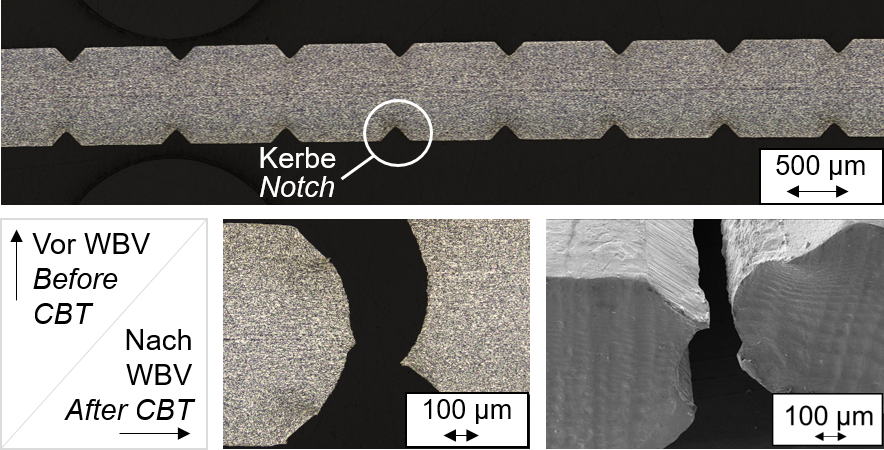
Notch Rolling and Cyclic Bending - Basic Investigations for the Production of Bulk Materials with a Low Aspect Ratio out of Strip Material
Third party funded individual grant
Start date : 01.04.2020
End date : 30.09.2024

Project details
Short description
Steel fibers applied in reinforced concrete contribute to the high strength and versatility of the composite. Conventionally produced by wire drawing, they show variations in their geometrical and mechanical properties. For a technologically and economically more efficient manufacturing, an alternative production procedure consisting of notch rolling and cyclic bending has been developed. At first a wire strip is created from a strip material by pressure forming. The following process step – cyclic bending – initiates predetermined breaking points on the formed webs through material fatigue. When finally breaking, they exhibit a smooth and burr-free parting surface. The resulting advantages are the easy-to-handle starting material, leading to a shortening of the process time with simultaneous homogeneity of the geometrical and mechanical properties. For directly adjusting these properties of the semi-finished products, a holistic understanding of the manufacturing procedure is required. Due to insufficient material-specific knowledge about the hardening and damage behavior, an evaluation of relevant process parameters is hardly possible so far.
The aim of this research project is a fundamental experimental and numerical analysis of the process chain of notch rolling and cyclic bending for the production of steel fibers. The holistic examination enables a determination of process influencing variables and interactions that are to be correlated with the process limits with regard to a process window. The mapping of the relevant characteristics of behavior for the numerical analysis base on selected material and damage models and experimentally determined characteristic values. The resulting simulation models of the two process steps are validated by analyzing the material flow and the process characteristics of the experimental implementation of the sub-processes. With the help of these models, a comparative evaluation of the effects of changes in process parameters is possible. Finally, the experimental and numerical combination of the process steps and their investigations enables an analysis of the process parameters and their interactions in the overall process.
Scientific Abstract
Zur Steigerung der Produktivität des Produktionsprozesses von Stahldrähten wird die Prozesskette Kerbwalzen und Wechselbiegen grundlegend analysiert. Während des Kerbwalzens werden beidseitig Kerben in ein Blechband geformt, in deren Bereichen der Werkstoff während des anschließenden Walkprozesses ermüdet und Risse entstehen. Die numerische und experimentelle Umsetzung beider Prozessschritte ermöglicht die Identifikation relevanter Einflussgrößen und deren Wechselwirkungen. Berücksichtigte Parameter sind u. a. beim Kerbwalzen der Kerbspitzenradius, der Kerbwinkel und die Stegdicke, sowie beim Wechselbiegen der Biegewinkel und die Zyklenzahl bis Bruch bzw. bis zur angestrebten Reststegdicke. Zur Bewertung der Materialtrennung sind numerische und experimentelle Studien der duktilen Schädigung erforderlich.
